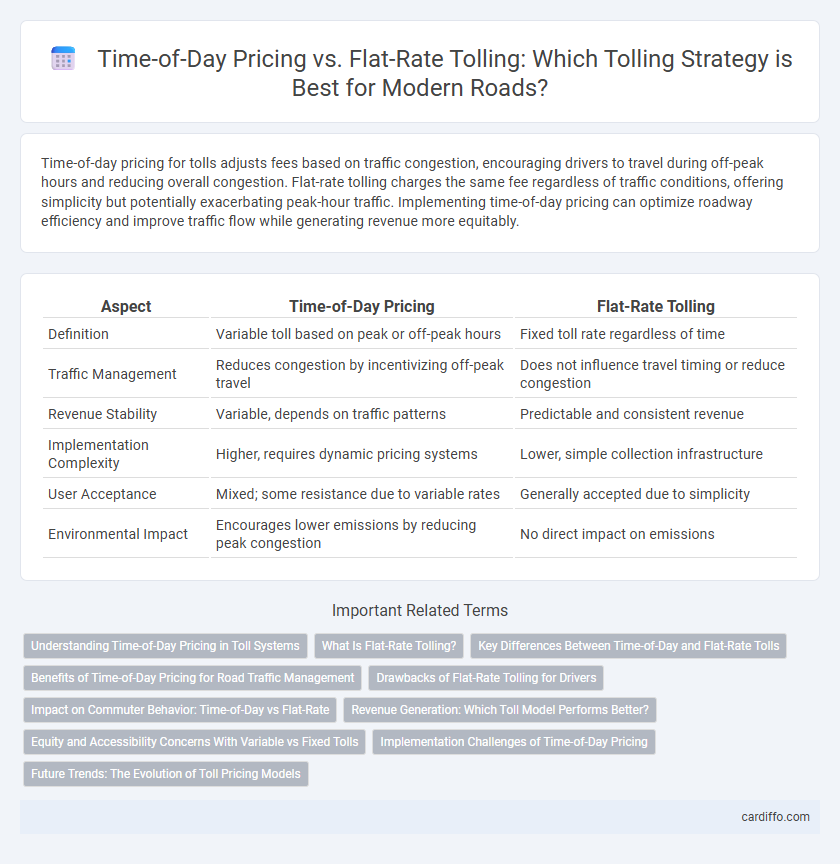Time-of-day pricing for tolls adjusts fees based on traffic congestion, encouraging drivers to travel during off-peak hours and reducing overall congestion. Flat-rate tolling charges the same fee regardless of traffic conditions, offering simplicity but potentially exacerbating peak-hour traffic. Implementing time-of-day pricing can optimize roadway efficiency and improve traffic flow while generating revenue more equitably.
Table of Comparison
| Aspect | Time-of-Day Pricing | Flat-Rate Tolling |
|---|---|---|
| Definition | Variable toll based on peak or off-peak hours | Fixed toll rate regardless of time |
| Traffic Management | Reduces congestion by incentivizing off-peak travel | Does not influence travel timing or reduce congestion |
| Revenue Stability | Variable, depends on traffic patterns | Predictable and consistent revenue |
| Implementation Complexity | Higher, requires dynamic pricing systems | Lower, simple collection infrastructure |
| User Acceptance | Mixed; some resistance due to variable rates | Generally accepted due to simplicity |
| Environmental Impact | Encourages lower emissions by reducing peak congestion | No direct impact on emissions |
Understanding Time-of-Day Pricing in Toll Systems
Time-of-day pricing in toll systems adjusts toll rates based on traffic patterns, charging higher fees during peak hours to manage congestion and incentivize off-peak travel. This dynamic pricing model improves roadway efficiency by reducing bottlenecks and balancing traffic loads throughout the day. Unlike flat-rate tolling, which imposes the same fee regardless of time, time-of-day pricing leverages real-time data to optimize traffic flow and enhance overall transportation network performance.
What Is Flat-Rate Tolling?
Flat-rate tolling charges drivers a fixed fee regardless of the time or traffic conditions, simplifying payment and predicting travel costs. This method contrasts with time-of-day pricing, which varies toll rates based on peak or off-peak hours to manage congestion and demand. Flat-rate tolling offers straightforward revenue collection but lacks incentives to reduce traffic during busy periods.
Key Differences Between Time-of-Day and Flat-Rate Tolls
Time-of-day pricing adjusts toll rates based on traffic demand during peak and off-peak hours, promoting congestion management and efficient roadway usage. Flat-rate tolling charges a consistent fee regardless of the time, offering simplicity and predictability for drivers. The key difference lies in demand responsiveness, where time-of-day pricing targets traffic reduction during busy periods, while flat-rate tolling emphasizes ease of administration and user understanding.
Benefits of Time-of-Day Pricing for Road Traffic Management
Time-of-day pricing effectively reduces traffic congestion by incentivizing drivers to travel during off-peak hours, leading to more balanced road usage throughout the day. This dynamic tolling approach decreases peak-hour traffic delays, lowers vehicle emissions, and improves overall travel times compared to flat-rate tolling systems. Transportation agencies benefit from enhanced traffic flow management, increased revenue flexibility, and better resource allocation by implementing time-dependent pricing strategies.
Drawbacks of Flat-Rate Tolling for Drivers
Flat-rate tolling often leads to increased congestion during peak hours as drivers face the same charges regardless of the time they travel, reducing incentives to avoid busy periods. This pricing model can result in inefficient traffic flow and longer commute times, impacting overall road network performance. Uniform toll rates also fail to promote demand management, limiting opportunities to optimize infrastructure usage and reduce environmental impacts from idling vehicles.
Impact on Commuter Behavior: Time-of-Day vs Flat-Rate
Time-of-day pricing influences commuter behavior by encouraging travel during off-peak hours, reducing congestion and improving traffic flow compared to flat-rate tolling. Studies show that variable toll rates lead to a significant shift in departure times as drivers seek lower fees, while flat-rate tolls maintain consistent commute patterns regardless of traffic conditions. Implementing dynamic tolling results in more efficient roadway usage and decreased peak-hour congestion, enhancing overall transportation system performance.
Revenue Generation: Which Toll Model Performs Better?
Time-of-day pricing optimizes revenue generation by charging higher tolls during peak traffic periods, effectively managing congestion and maximizing income from high-demand intervals. Flat-rate tolling offers predictable and consistent revenue but often misses opportunities to capitalize on fluctuating traffic volumes and willingness to pay. Studies indicate dynamic toll models yield 15-30% higher revenue compared to flat rates, especially in metropolitan areas with significant traffic variability.
Equity and Accessibility Concerns With Variable vs Fixed Tolls
Time-of-day pricing in tolling introduces equity challenges by disproportionately impacting low-income drivers who often work non-flexible hours and cannot avoid peak pricing, whereas flat-rate tolling offers predictable costs that enhance accessibility. Variable tolls can incentivize off-peak travel but may limit affordability for disadvantaged communities lacking alternative transportation options. Ensuring equitable toll systems requires balancing revenue goals with accessibility through targeted discounts or exemptions for vulnerable populations.
Implementation Challenges of Time-of-Day Pricing
Time-of-day pricing faces implementation challenges such as the need for advanced tolling infrastructure capable of real-time data processing and enforcement. Public acceptance issues arise due to perceived fairness, requiring extensive communication campaigns and stakeholder engagement. Integrating dynamic pricing algorithms with existing traffic management systems also demands significant technical expertise and investment.
Future Trends: The Evolution of Toll Pricing Models
Time-of-day pricing adapts toll rates based on traffic patterns, encouraging off-peak travel and reducing congestion during peak hours, a trend gaining traction with smart infrastructure advancements. Flat-rate tolling offers simplicity and predictability but lacks flexibility to manage demand dynamically, which is increasingly insufficient for evolving urban mobility needs. Future toll pricing models will likely integrate real-time data analytics and AI-driven algorithms to optimize traffic flow and enhance revenue efficiency, signaling a shift towards more adaptive and responsive toll systems.
Time-of-day pricing vs flat-rate tolling Infographic

 cardiffo.com
cardiffo.com